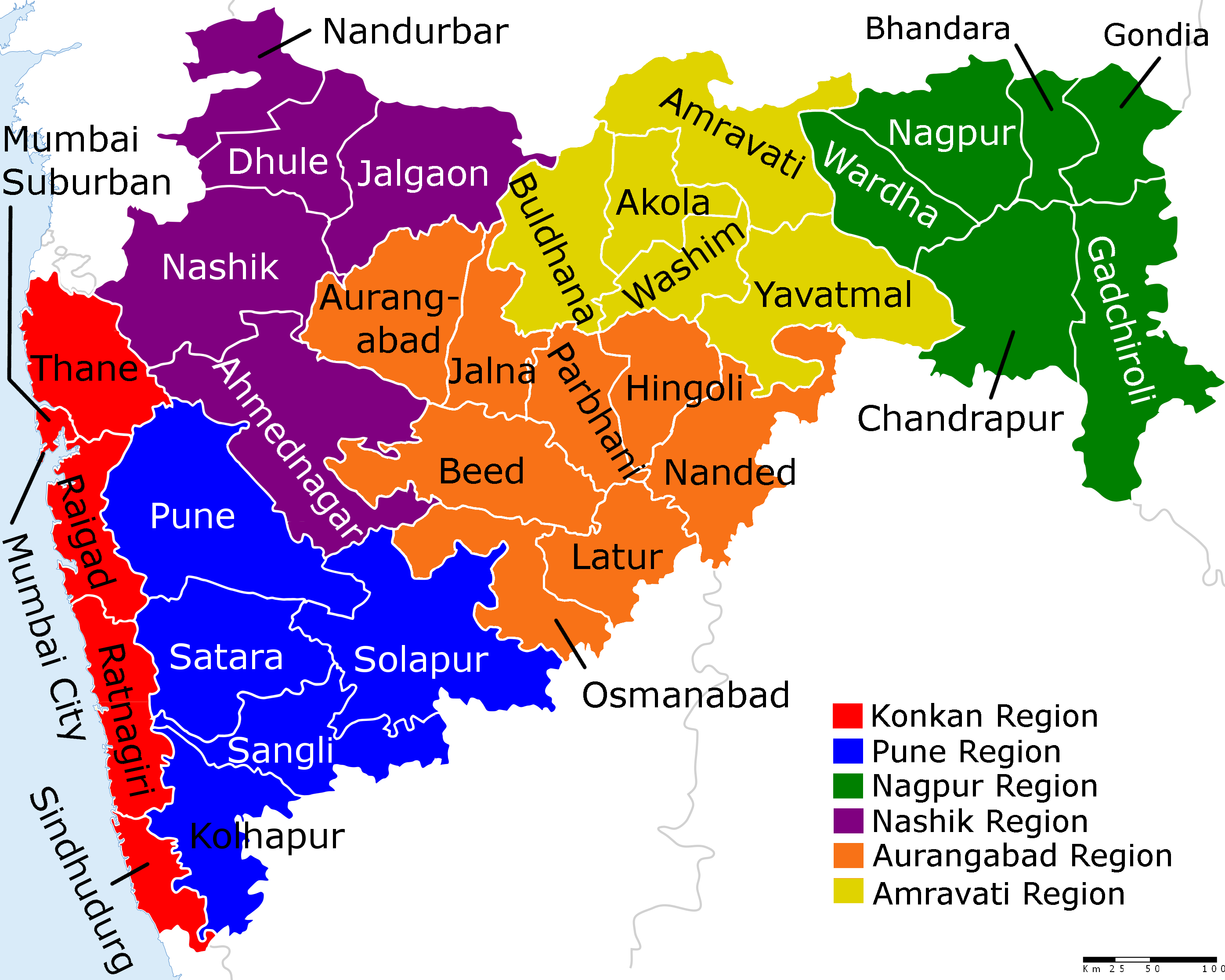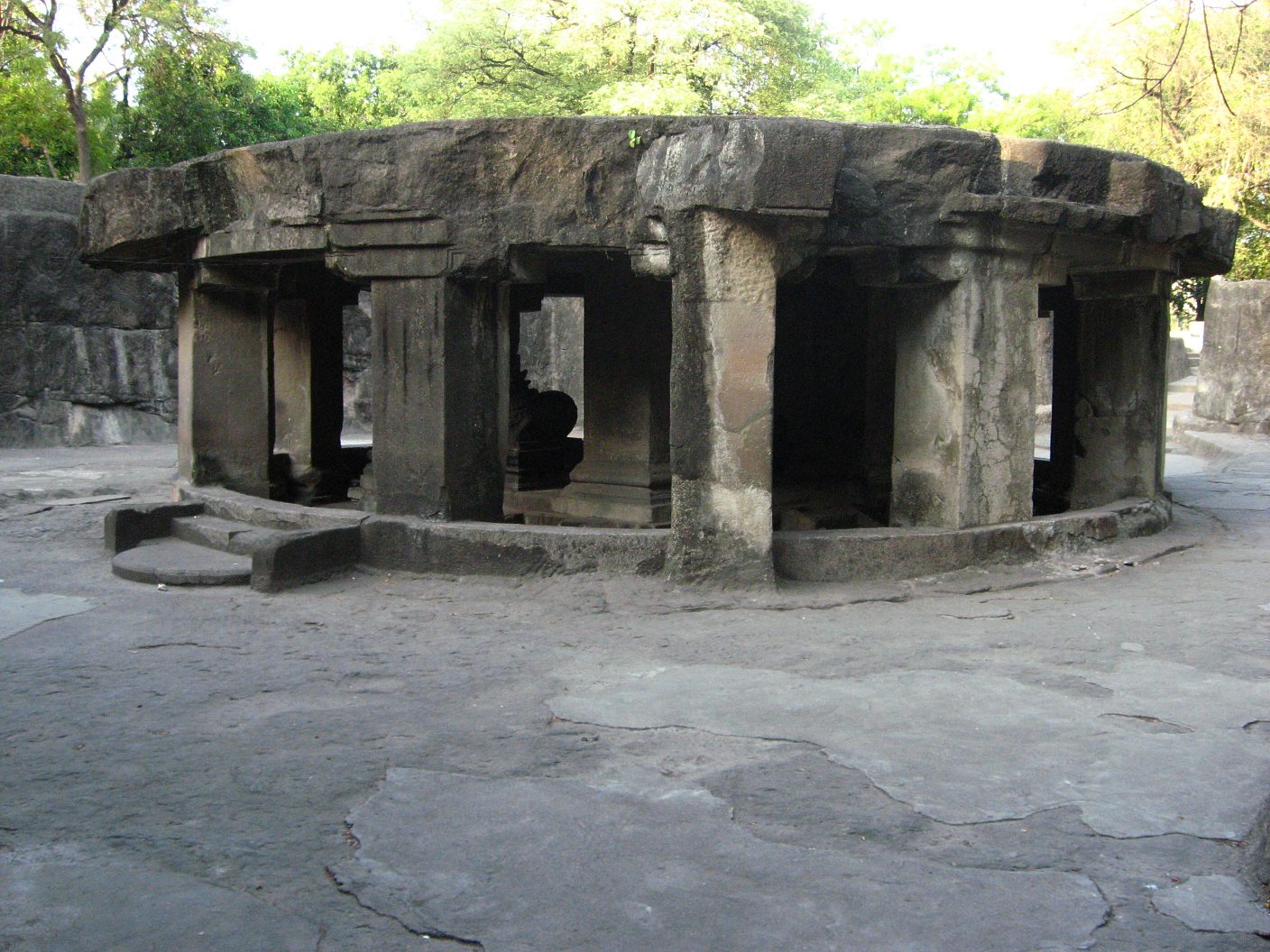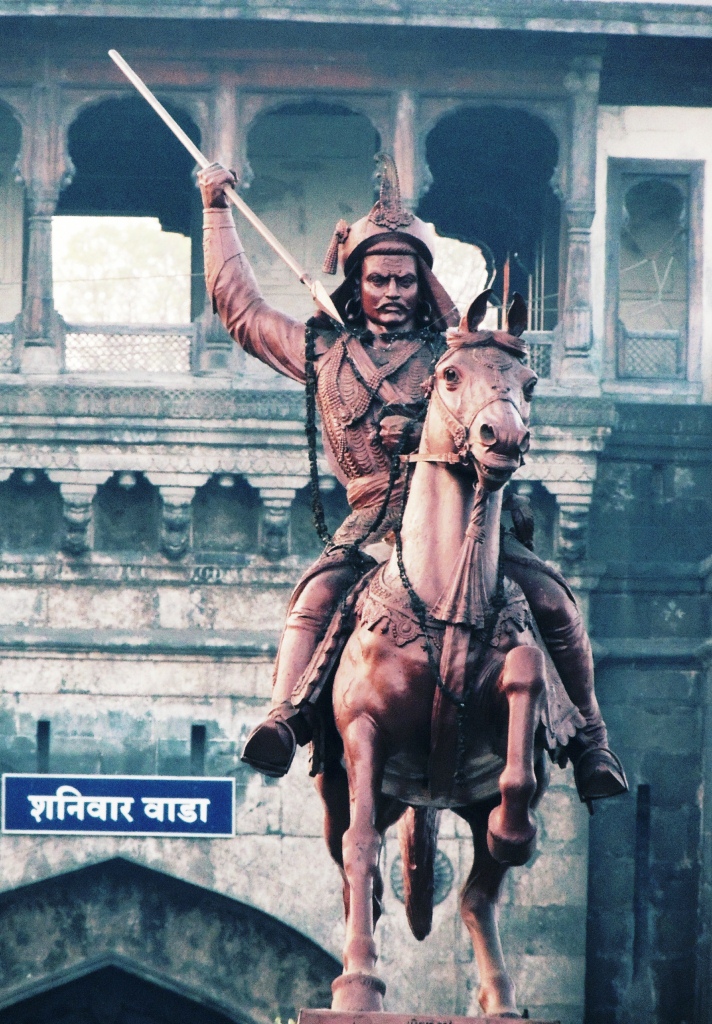|
Junnar, Maharashtra
Junnar (Marathi pronunciation: ͡ʒunːəɾ is a city in the Pune district of the Indian state of Maharashtra. The city has history dating back to the first millennium. The nearby fort of Shivneri was the birthplace of Maratha king Chatrapati Shivaji Maharaj, the founder of the Maratha Empire. Junnar was declared the first tourism taluka in Pune district by the government of Maharashtra on 9 January 2018. History Junnar has been an important trading and political centre for the last two millennia. The town is on the trade route that links the ports of western India or more specifically of Konkan with Deccan interiors. The first mention of Junnar comes the Greco-Roman travellers from the first millennium, The Indo-Scythian Western Satraps ruled at Junnar during the 2nd century CE as shown by their cave inscriptions in the area of Junnar, at Manmodi Caves. "Yavana" Greeks also left donative inscriptions in the 2nd century CE at Lenyadri and Manmodi Caves. According to Damod ... [...More Info...] [...Related Items...] OR: [Wikipedia] [Google] [Baidu] |
Pune District
Pune district (Marathi pronunciation: uɳeː is the most populous district in the Indian state of Maharashtra. The district's population was 9,429,408 in the 2011 census, making it the fourth most populous district amongst India's 640 districts. This district has an urban population of 58.08 percent of its total. It is one of the most industrialized districts in India. In recent decades it has also become a hub for information technology. Officer Members of Parliament * Girish Bapat ( BJP) - * Supriya Sule ( NCP) - * Dr. Amol Kolhe ( NCP) - * Shrirang Barne (BSS) - Guardian Minister list of Guardian Minister District Magistrate/Collector list of District Magistrate / Collector District Justice District Police Commissioner list of District Police Commissioner President & Vice-President Zilla Parishad *President list of President Zilla Parishad Pune *Vice-President list of Vice-President Zilla Parishad Pune Chief Executive Off ... [...More Info...] [...Related Items...] OR: [Wikipedia] [Google] [Baidu] |
Yavana
The word Yona in Pali and the Prakrits, and the analogue Yavana in Sanskrit and Yavanar in Tamil, were words used in Ancient India to designate Greek speakers. "Yona" and "Yavana" are transliterations of the Greek word for " Ionians" ( grc, Ἴωνες < Ἰάoνες < *Ἰάϝoνες), who were probably the first Greeks to be known in the East. Both terms appear in ancient literature. ''Yavana'' appears, for instance, in the '''', while ''Yona'' appears in texts such as the n chronicle '' Mahavamsa''. The Yona are me ... [...More Info...] [...Related Items...] OR: [Wikipedia] [Google] [Baidu] |
Peshwa
The Peshwa (Pronunciation: e(ː)ʃʋaː was the appointed (later becoming hereditary) prime minister of the Maratha Empire of the Indian subcontinent. Originally, the Peshwas served as subordinates to the Chhatrapati (the Maratha king); later, under the Bhat family, they became the ''de facto'' leaders of the Maratha Confederacy, with the Chhatrapati becoming a nominal ruler. During the last years of the Maratha Empire, the Peshwas themselves were reduced to titular leaders, and remained under the authority of the Maratha nobles and the British East India Company. All Peshwas during the rule of Shivaji, Sambhaji and Rajaram belonged to Deshastha Brahmin community. The first Peshwa was Moropant Pingle, who was appointed as the head of the Ashta Pradhan (council of eight ministers) by Chhatrapati Shivaji Maharaj, the founder of the Maratha Empire. The initial Peshwas were all ministers who served as the chief executives to the king. The later Peshwas held the highest admin ... [...More Info...] [...Related Items...] OR: [Wikipedia] [Google] [Baidu] |
Pune
Pune (; ; also known as Poona, ( the official name from 1818 until 1978) is one of the most important industrial and educational hubs of India, with an estimated population of 7.4 million As of 2021, Pune Metropolitan Region is the largest in Maharashtra by area, with a geographical area of 7,256 sq km. It has been ranked "the most liveable city in India" several times. Pune is also considered to be the cultural and educational capital of Maharashtra. Along with the municipal corporation area of PCMC, PMC and the three cantonment towns of Camp, Khadki, and Dehu Road, Pune forms the urban core of the eponymous Pune Metropolitan Region (PMR). Situated {{convert, 560, m, 0, abbr=off above sea level on the Deccan plateau, on the right bank of the Mutha river,{{cite web , last=Nalawade , first=S.B. , url=http://www.ranwa.org/punealive/pageog.htm , title=Geography of Pune Urban Area , publisher=Ranwa , access-date=4 April 2008 , archive-url=https://web.archive.org/web/20071 ... [...More Info...] [...Related Items...] OR: [Wikipedia] [Google] [Baidu] |
Shaniwar Wada
Shaniwar Wada is a historical fortification in the city of Pune, India. Built in 1732, it was the great seat of the Peshwas of the Maratha Empire until 1818. Following the rise of the Maratha Empire, the palace became the center of Indian politics in the 18th century. The fort itself was largely destroyed in 1828 by an unexplained fire, but the surviving structures are now maintained as a tourist site. History The Shaniwar Wada was normally the seven-story capital building of the Peshwas of the Maratha Empire. It was supposed to be made entirely of stone but after the completion of the base floor or the first story, the people of Satara (the national capital) complained to the Chatrapati Shahu Maharaj(King) saying that a stone monument can be sanctioned and built only by the king himself and not the Peshwas. Following this, an official letter was written to the Peshwas stating that the remaining building had to be made of brick and not stone. Even today if you visit and see ... [...More Info...] [...Related Items...] OR: [Wikipedia] [Google] [Baidu] |
Shivneri Fort1
Shivneri Fort (Marathi pronunciation: �iʋneɾiː is a 17th-century military fortification located near Junnar in Pune district in Maharashtra, India. It is the birthplace of Shivaji, the emperor and founder of Maratha Empire. History Shivneri is known to be a place of Buddhist dominion from the 1st century AD. Its caves, rock-cut architecture and water system indicate the presence of habitation since 1st century AD. Shivneri got its name as it was under the possession of the Yadavas of Devagiri. This fort was mainly used to guard the old trading route from Desh to the port city of Kalyan. The place passed on to the Bahmani Sultanate after the weakening of Delhi Sultanate during the 15th century and it then passed on to the Ahmadnagar Sultanate in the 16th century. In 1595, a Maratha chief named Maloji Bhonsle, the grandfather of Shivaji Bhosale, was enabled by the Ahmadnagar Sultan, Bahadur Nizam Shah and he gave him Shivneri and Chakan. Shivaji was born at the fort on 19 ... [...More Info...] [...Related Items...] OR: [Wikipedia] [Google] [Baidu] |
Shahaji
Shahaji Bhonsale (Pronunciation: �əɦad͡ʒiː c. 1594 – 1664) was a military leader of India in the 17th century, who served the Ahmadnagar Sultanate, the Bijapur Sultanate, and the Mughal Empire at various points in his career. As a member of the Bhonsle clan, Shahaji inherited the Pune and Supe jagirs (fiefs) from his father Maloji, who served Ahmadnagar. During the Mughal invasion of Deccan, he joined the Mughal forces and served under Emperor Shah Jahan for a short period. After being deprived of his jagirs, he defected to the Bijapur Sultanate in 1632 and regained control over Pune and Supe. In 1638, he received the jagir of Bangalore after Bijapur's invasion of Kempe Gowda III's territories. He became the chief general of Bijapur and oversaw its expansion. He brought the house of Bhosale into prominence. He was the father of Shivaji, the founder of the Maratha Empire. The princely states of Tanjore, Kolhapur, and Satara were ruled by Shahaji's descendants. Earl ... [...More Info...] [...Related Items...] OR: [Wikipedia] [Google] [Baidu] |
Shivaji
Shivaji Bhonsale I (; 19 February 1630 – 3 April 1680), also referred to as Chhatrapati Shivaji Maharaj, was an Indian ruler and a member of the Bhonsle Maratha clan. Shivaji carved out his own independent kingdom from the declining Adilshahi sultanate of Bijapur which formed the genesis of the Maratha Empire. In 1674, he was formally crowned the '' Chhatrapati'' of his realm at Raigad Fort. Over the course of his life, Shivaji engaged in both alliances and hostilities with the Mughal Empire, the Sultanate of Golkonda, Sultanate of Bijapur and the European colonial powers. Shivaji's military forces expanded the Maratha sphere of influence, capturing and building forts, and forming a Maratha navy. Shivaji established a competent and progressive civil rule with well-structured administrative organisations. He revived ancient Hindu political traditions, court conventions and promoted the usage of the Marathi and Sanskrit languages, replacing Persian in court and admi ... [...More Info...] [...Related Items...] OR: [Wikipedia] [Google] [Baidu] |
Nizam Shahi
The Ahmadnagar Sultanate was a late medieval Indian Muslim kingdom located in the northwestern Deccan, between the sultanates of Gujarat and Bijapur. Malik Ahmed, the Bahmani governor of Junnar after defeating the Bahmani army led by general Jahangir Khan on 28 May 1490 declared independence and established the Nizam Shahi dynasty rule over the sultanate of Ahmednagar. Initially his capital was in the town of Junnar with its fort, later renamed Shivneri. In 1494, the foundation was laid for the new capital Ahmadnagar. In 1636 Aurangzeb, then Mugal viceroy of Deccan, finally annexed the sultanate to the Mughal Empire. Ahmednagar sultanate was dependent on Koli chieftains for military or soldiers. Koli chieftains of provided the cavalry and infantry for Sultans of Ahmednagar during wartimes. History Establishment Malik Ahmad Nizam Shah I was the son of Nizam-ul-Mulk Malik Hasan Bahri, originally a Hindu Brahmin from Beejanuggar (or Bijanagar) originally named Timapa. Ahme ... [...More Info...] [...Related Items...] OR: [Wikipedia] [Google] [Baidu] |
Malik Ambar
Malik Ambar (1548 – 13 May 1626) was a Siddi military leader and prime minister who became a kingmaker and de facto ruler of the Ahmadnagar Sultanate in the Deccan region of India. Born in the Adal Sultunate, in present-day Ethiopia, Malik was sold by a slave merchant and brought to India as a slave. While in India he created a mercenary force numbering greater than 50,000 men. It was based in the Deccan region and was hired by local kings. Malik became a popular Prime Minister of the Ahmadnagar Sultanate, showing administrative acumen. He is also regarded as a pioneer in guerrilla warfare in the region. He is credited with carrying out a revenue settlement of much of the Deccan, which formed the basis for subsequent settlements. He is a figure of veneration to the Siddis of Gujarat. He humbled the might of the Mughals and Adil Shahs of Bijapur and raised the low status of the Nizam Shah.Michell, George & Mark Zebrowski. ''Architecture and Art of the Deccan Sultanates'' ... [...More Info...] [...Related Items...] OR: [Wikipedia] [Google] [Baidu] |
Bahamani
The Bahmani Sultanate, or Deccan, was a Persianate Sunni Muslim Indian Kingdom located in the Deccan region. It was the first independent Muslim kingdom of the Deccan,Ansari, N.H. "Bahmanid Dynasty" ''Encyclopaedia Iranica'' and was known for its perpetual wars with its rival , which would outlast the Sultanate. The Sultanate was founded in 1347 by Ala-ud-Din Bahman Shah. It later split into five successor states that were collectively known as the |





.png)
.jpg)
